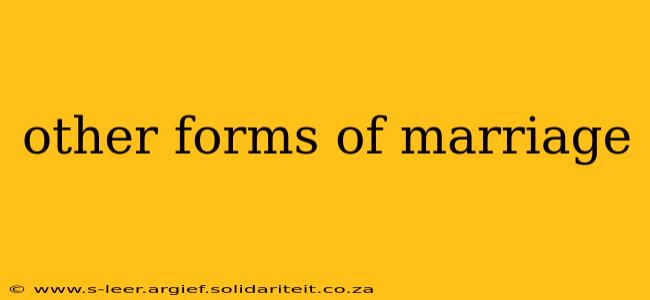The institution of marriage, while seemingly universal, takes on a breathtaking array of forms across cultures and throughout history. What we often consider "traditional marriage" – a legally recognized union between two people – is only one facet of a much richer and more complex tapestry of human relationships. This exploration delves into other forms of marriage, examining their structures, societal contexts, and enduring legacies.
What are some examples of different types of marriage?
This question opens the door to a vast landscape of marital structures. We can categorize them in various ways, including:
-
Monogamy: The most common form in many Western societies, involving marriage between two individuals. Even within monogamy, variations exist – serial monogamy (successive monogamous relationships) differs significantly from lifelong monogamy.
-
Polygamy: This umbrella term encompasses marriage involving more than two partners. It further divides into:
- Polygyny: One man married to multiple women. This practice is prevalent in many parts of Africa, Asia, and the Middle East, often rooted in cultural and economic factors.
- Polyandry: One woman married to multiple men. This is far less common than polygyny, historically found in certain regions of Tibet, Nepal, and parts of India, often driven by resource scarcity.
-
Group Marriage: This involves multiple men and women married to each other simultaneously. This is a relatively rare form, with limited historical examples and often associated with specific communities or religious beliefs.
-
Trial Marriage: Also known as cohabitation, this involves couples living together before formalizing their relationship through marriage. This is gaining increasing acceptance in many modern societies as a way to test compatibility before committing to a lifelong union.
What is the difference between civil and religious marriage?
The distinction between civil and religious marriage lies in the authority bestowing the marital status.
-
Civil Marriage: This is a legal contract recognized by the state, typically involving a ceremony performed by a civil official, like a judge or registrar. The legal aspects of marriage – inheritance, property rights, etc. – are solely determined by civil law.
-
Religious Marriage: This is a marriage ceremony performed according to the rites and beliefs of a particular religion. While often legally recognized (depending on the jurisdiction and the specific religious institution), the religious ceremony itself is not legally binding in all contexts. The religious aspects of marriage – spiritual union, faith-based vows, etc. – take precedence.
Are there any historical examples of different marriage practices?
History is replete with diverse marriage customs. Examples include:
-
Arranged Marriages: Common in many cultures throughout history, these unions are orchestrated by families, often based on factors such as economic benefit or social standing, rather than romantic love.
-
Levirate Marriage: In certain societies, a widow was expected to marry her deceased husband's brother, often to ensure the continuation of the family line and to provide for the widow.
-
Sororate Marriage: Similarly, if a wife died, the husband might marry her sister. These practices, while seemingly unusual from a modern perspective, were integral aspects of kinship systems in numerous cultures.
What are the legal implications of different forms of marriage?
The legal implications of various marriage forms vary dramatically depending on the jurisdiction. Some countries legally recognize polygamy, while others strictly prohibit it. The recognition of same-sex marriage is also a significant legal development in recent decades, reflecting societal shifts in attitudes toward marriage. Legal frameworks regarding property rights, inheritance, and child custody often differ significantly based on the type of marriage and the legal system in question.
Conclusion: A Tapestry of Human Relationships
The concept of "marriage" is far from monolithic. This exploration provides only a glimpse into the vast spectrum of marital forms across cultures and time. Understanding these variations is crucial for fostering inclusivity, respecting cultural differences, and appreciating the richness and diversity of human relationships. Further research into specific cultural practices and historical periods will reveal even greater complexities and nuances within this fascinating social institution.
